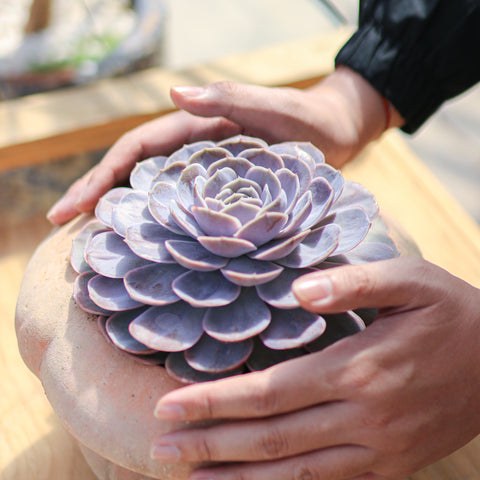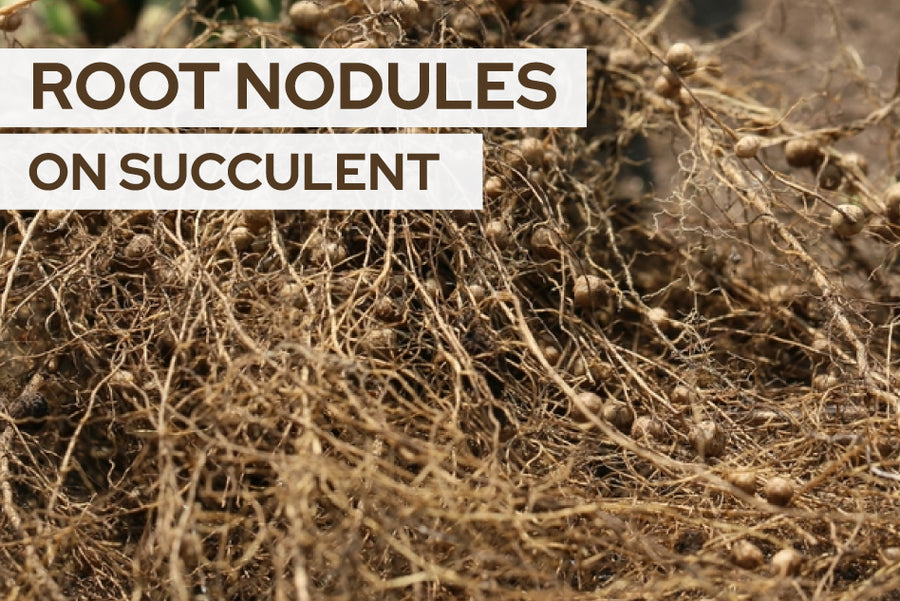If you are searching for “small lumps on succulent roots” and landing on our page, does this below story sound familiar?
It is a bright, sunny day, and you are caring for your succulent collection. As you carefully lift one of your plants from its pot for a routine repotting session, something catches your eye. Nestled among the tangle of roots are peculiar oval or round-shaped growths, small and delicate, in shades of beige-pink or yellow. They almost resemble tiny pearls, attached firmly to the roots like miniature ornaments. What are these mysterious growths? Could they be a sign of trouble for your cherished succulent?

Let me tell you, although discovering these strange growths among your succulent roots might seem odd, they're actually quite common in nature. These formations, known as root nodules, have been observed for centuries, showing how plants adapt to their environment to survive. So, while it might be surprising to find them in your succulent, root nodules are a natural and fascinating part of plant life. To determine whether the root nodules on your succulents are beneficial or detrimental, further observations are necessary.
What Are Root Nodules?
Root nodules are specialized structures that develop on the roots of certain plants as part of a symbiotic relationship with nitrogen-fixing bacteria or other microorganisms. These nodules serve as a unique habitat for these beneficial bacteria, providing them with a cozy environment to live and thrive. Within these nodules, the bacteria engage in a remarkable process called nitrogen fixation, where they convert atmospheric nitrogen into a form that plants can readily absorb and utilize for their growth and development. In some rare cases, root nodules can also be harmful if they contain parasitic nematodes. These microscopic worms can damage and disrupt the plant's root system.
Root nodules can vary in appearance, depending on the plant species and the specific bacteria involved in the symbiosis. They may appear as small, round or oval-shaped growths attached to the roots, often exhibiting distinctive colors such as pink, yellow, or even white. While root nodules are commonly associated with certain types of plants, they can randomly appear in most plants.
Why Do Plants Grow Root Nodules?
Plants develop root nodules to acquire nitrogen, an essential nutrient for their growth and development. Although nitrogen gas constitutes a significant portion of the Earth's atmosphere, plants, animals, and humans cannot directly utilize it. Unlike animals and humans, which obtain nitrogen from food sources, plants rely on alternative mechanisms to access this vital element. Root nodules serve as a solution for plants to obtain nitrogen by creating a symbiotic relationship with nitrogen-fixing bacteria or other microorganisms present in the soil. Through this symbiosis, plants can efficiently utilize atmospheric nitrogen, which would otherwise be inaccessible to them. While modern agriculture often relies on synthetic fertilizers to supply nitrogen and other nutrients to plants, the process of nitrogen fixation through root nodules is still an important part of nature.
Root nodules play a crucial role in the nitrogen cycle, allowing plants to access nitrogen. Within the root nodules, bacteria convert atmospheric nitrogen into ammonia or other forms of nitrogen that plants can readily absorb and utilize for various metabolic processes. This benefits both the plants and the bacteria involved, as the plants gain access to essential nutrients, while the bacteria receive a source of energy in the form of carbohydrates produced by the plants through photosynthesis. Interestingly, not all plants have the ability to form root nodules, and this trait is often limited to specific plant families or species. Additionally, the formation of root nodules is influenced by environmental factors such as soil nitrogen levels, pH, and the presence of compatible nitrogen-fixing bacteria. Overall, root nodules represent a fascinating adaptation that enables plants to thrive in diverse ecosystems.
Root Nodules In Symbiosis - The Coexistence Between Plants and Microorganisms
Symbiosis indicates the coexistence between plants and microorganisms, is a fascinating phenomenon that underscores the interconnection of the natural world. In this delicate partnership, plants and microorganisms, such as bacteria, fungi, and algae, form intimate relationships where both parties derive mutual benefits. Whether through nutrient exchange, protection from predators, or enhanced resilience to environmental stresses, symbiotic interactions play a crucial role in shaping ecosystems and sustaining life on Earth.
Root nodules are one prominent symbol of symbiosis. Host plants and nitrogen-fixing bacteria find each other through a sophisticated exchange of chemical signals. When plants release specific chemicals into the soil, these signals act as cues for nearby bacteria, indicating the presence of compatible host plants. In response, the bacteria release their own chemicals and initiate the symbiotic relationship. The way plants and bacteria communicate with each other is very precise, with only certain types of bacteria able to talk to specific kinds of plants. Scientists are still studying exactly how this communication works, and while they know a lot, there are still some parts they don't fully understand. But this back-and-forth signaling between plants and bacteria shows just how amazing and adaptable nature can be when it comes to living together and helping each other out.

Are Root Nodules Common On Succulents?
Root nodules in succulents are relatively uncommon when compared to plants like legumes. Succulents typically thrive in arid environments where nitrogen availability may be limited, but they have adapted to utilize nitrogen from the soil rather than from nitrogen-fixing bacteria. However, certain succulent species, particularly those belonging to the legume family (Fabaceae), may have the capability to form root nodules and engage in nitrogen-fixing symbiotic relationships with bacteria. Some examples are Adenolobus garipensis "Quartz Hill pea", Pseudarthria hookeri "Hooker's peas," and Smithia conferta "Tuber smithia”.
Additionally, some other succulent species, particularly those that grow in nutrient-poor or harsh environments, may have evolved mechanisms for accessing nitrogen from the air or soil without forming root nodules. These plants may have specialized root structures or associations with microbial communities that facilitate nitrogen uptake. So, in some rare cases, root nodules actually indicate an issue such as a parasitic infection, root disease, or other stressors. It's essential to inspect the nodules carefully and assess the overall health of the plant. If the nodules appear abnormal or if the succulent shows signs of decline, it's advisable to take appropriate measures to address any underlying problems to promote the plant's well-being.
Should We Remove Root Nodules On Succulents?
If your succulents appear healthy and thriving, removing root nodules from succulents is generally not necessary. In some cases, these nodules serve as hubs for a symbiotic partnership between the succulent and nitrogen-fixing bacteria. Disrupting this relationship by removing the nodules could deprive the succulent of a vital nitrogen source, potentially harming its growth and development. Unless the nodules are causing visible issues or the plant is showing signs of distress, it's advisable to leave them undisturbed.
Can Root Nodules Be Problematic?
With succulents, root nodules are not always healthy. Non-legume root nodules can sometimes become hosts for parasitic nematodes. These microscopic worms can invade the root nodules, causing damage and disrupting the normal functions of the plant's root system. Unlike the beneficial relationship between legumes and nitrogen-fixing bacteria, the presence of parasitic nematodes can be detrimental to the health and growth of the plant. It's important to be aware of the potential risks associated with nematode infestation in non-legume plants, such as succulents, and to take preventive measures to protect their plants from these parasites.
Detecting unhealthy root nodules in succulents can be challenging, as their symptoms sometimes are difficult to see. However, several signs may indicate that the nodules are affected by parasitic nematodes, such as the presence of discoloration or abnormalities of the nodules. Healthy nodules typically exhibit a firm, rounded structure with a consistent coloration, while unhealthy nodules may appear discolored, swollen, or distorted. Additionally, plants with infested root nodules may exhibit symptoms of stress or decline, such as stunted growth, wilting foliage, or yellowing leaves. In severe cases, the root system may show signs of decay or rot, further compromising the plant's overall health. Regular monitoring of plant health, combined with careful observation of root nodules during repotting or soil examination, can help identify and address issues with non-legume root nodules before they escalate into more significant problems.
Do Root Nodules Indicate A Need For Fertilizer?
Root nodules on succulents do not necessarily indicate a need for more fertilizer. Unlike legumes, which form nodules as part of a symbiotic relationship with nitrogen-fixing bacteria to obtain nitrogen from the air, most succulents typically do not form these nodules for nitrogen fixation. Some succulents in the Fabaceae family do, as mentioned above, but those are very rare cases.
Succulents normally rely on other methods to acquire nutrients, such as absorbing them from the soil or through foliar uptake. Therefore, the presence of root nodules on succulents may be a sign of a parasitic infection rather than a need for additional fertilizer. It's essential to assess the overall health of the plant and consider other factors before applying fertilizer, as over-fertilization can lead to nutrient imbalances and harm the succulent. If you notice root nodules on your succulent, it's advisable to inspect them carefully and address any underlying issues, such as pest infestations or soil conditions, rather than automatically applying fertilizer.
































































































